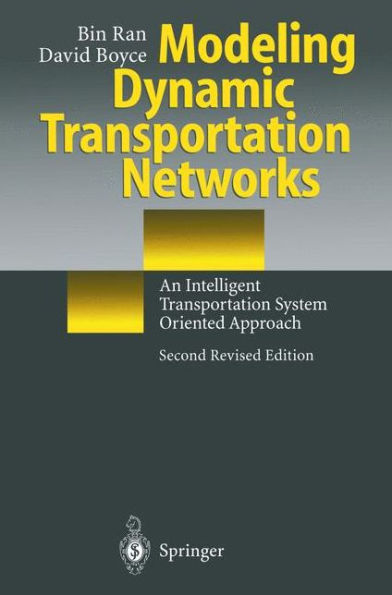Modeling Dynamic Transportation Networks: An Intelligent Transportation System Oriented Approach
This book seeks to summarize our recent progress in dynamic trans portation network modeling. It concentrates on ideal dynamic network models based on actual travel times and their corresponding solution algorithms. In contrast, our first book DynamIc Urban Transportation Network Models - The ory and Implications for Intelligent Vehicle-Hzghway Systems (Springer-Verlag, 1994) focused on instantaneous dynamic network models. Comparing the two books, the major differences can be summarized as follows: 1. This book uses the variational inequality problem as the basic formulation approach and considers the optimal control problem as a subproblem for solution purposes. The former book used optimal control theory as the basic formulation approach, which caused critical problems in some circumstances. 2. This book focuses on ideal dynamic network models based on actual travel times. The former book focused on instantaneous dynamic network models based on currently prevailing travel times. 3. This book formulates a shastic dynamic route choice model which can utilize any possible route choice distribution function instead of only the logit function. 4. This book reformulates the bilevel problem of combined departure time/ route choice as a one-level variational inequality. 5. Finally, a set of problems is provided for classroom use. In addition, this book offers comprehensive insights into the complexity and challenge of applying these dynamic network models to Intelligent Trans portation Systems (ITS). Nevertheless, the models in this text are not yet fully evaluated and are subject to revision based on future research.
1111487105
Modeling Dynamic Transportation Networks: An Intelligent Transportation System Oriented Approach
This book seeks to summarize our recent progress in dynamic trans portation network modeling. It concentrates on ideal dynamic network models based on actual travel times and their corresponding solution algorithms. In contrast, our first book DynamIc Urban Transportation Network Models - The ory and Implications for Intelligent Vehicle-Hzghway Systems (Springer-Verlag, 1994) focused on instantaneous dynamic network models. Comparing the two books, the major differences can be summarized as follows: 1. This book uses the variational inequality problem as the basic formulation approach and considers the optimal control problem as a subproblem for solution purposes. The former book used optimal control theory as the basic formulation approach, which caused critical problems in some circumstances. 2. This book focuses on ideal dynamic network models based on actual travel times. The former book focused on instantaneous dynamic network models based on currently prevailing travel times. 3. This book formulates a shastic dynamic route choice model which can utilize any possible route choice distribution function instead of only the logit function. 4. This book reformulates the bilevel problem of combined departure time/ route choice as a one-level variational inequality. 5. Finally, a set of problems is provided for classroom use. In addition, this book offers comprehensive insights into the complexity and challenge of applying these dynamic network models to Intelligent Trans portation Systems (ITS). Nevertheless, the models in this text are not yet fully evaluated and are subject to revision based on future research.
54.99
In Stock
5
1

Modeling Dynamic Transportation Networks: An Intelligent Transportation System Oriented Approach
356
Modeling Dynamic Transportation Networks: An Intelligent Transportation System Oriented Approach
356Paperback(2nd ed. 1996. Softcover reprint of the original 2nd ed. 1996)
$54.99
54.99
In Stock

Product Details
| ISBN-13: | 9783642802324 |
|---|---|
| Publisher: | Springer Berlin Heidelberg |
| Publication date: | 12/10/2011 |
| Edition description: | 2nd ed. 1996. Softcover reprint of the original 2nd ed. 1996 |
| Pages: | 356 |
| Product dimensions: | 6.10(w) x 9.25(h) x 0.03(d) |
From the B&N Reads Blog
